The Belt and Road Initiative (BRI), proposed by Chinese President Xi Jinping in 2013, is an international initiative with vital implications for the economy, society, culture, and the environment. Though the BRI itself conveys rich social and economic connotations, ecosystem health and the environmental problems in the Belt and Road regions are scientific issues. In this study, papers relating to the ecological issues of the BRI between January 2013 and December 2021 were collected and analyzed via CiteSpace. We found that some ecological issues were, to a certain extent, subjective assumptions. By emphasizing that scientific data is key to explaining the ecological problems, we advanced four prospects for ecosystem health and environmental geography studies in the Belt and Road Regions: (1) Spatial analysis and monitoring technology for the environment; (2) Clarification of the characteristics and mechanisms of the ecosystem and environments; (3) A focus on the interaction between the economy and the environment; (4) Specific and targeted strategies and solutions to different environmental problems.
- the Belt and Road Initiative (BRI)
- environmental geography
- ecosystem services
- regional development
1. Backgrounds of the Belt and Road Initiative
2. Quantitative Analysis of Environmental Studies Relating to the Belt and Road Initiative
2.1. Publications and Citations
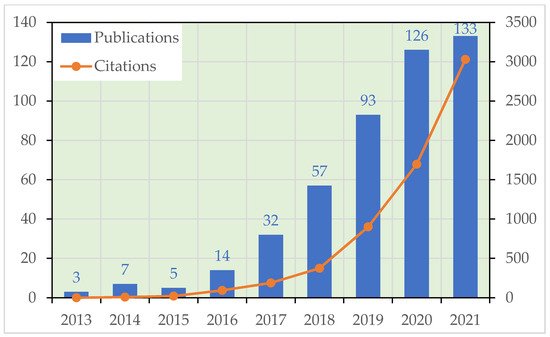
2.2. Interested Countries and Regions
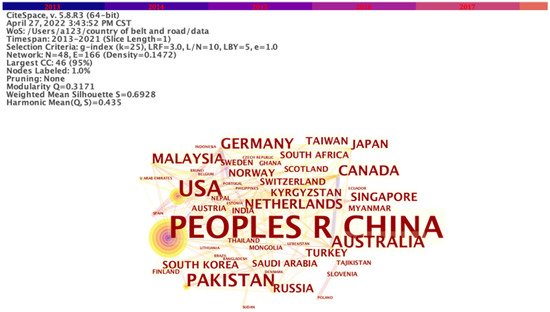
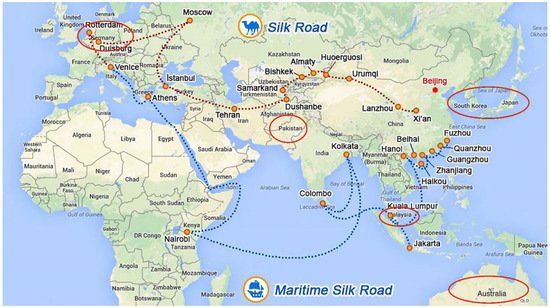
2.3. The Evolution of Research Hotspots
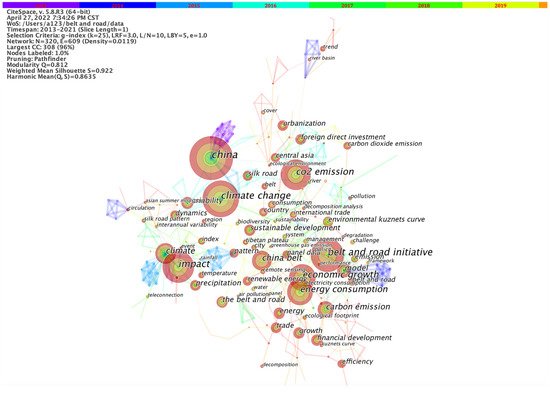
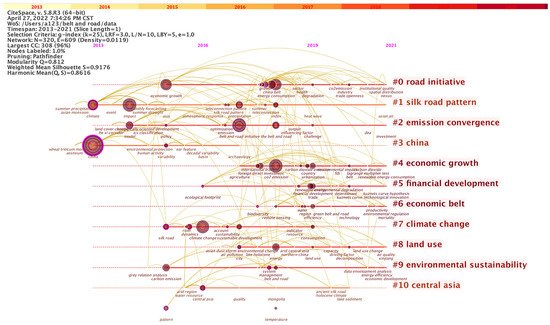
2.4. The Development Venation of Research
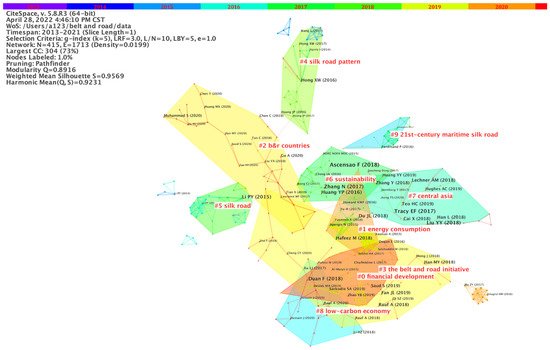
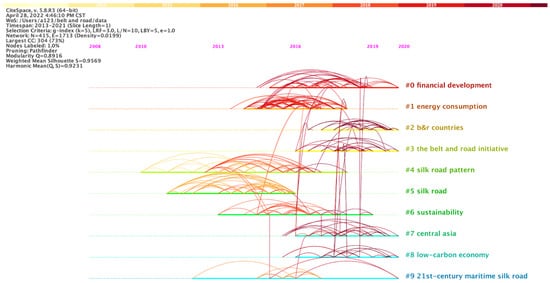
3. Ecological Problems in the Belt and Road Regions
3.1. Biotic Environment Challenges
3.1.1. Biodiversity Loss
Terrestrial Biodiversity Loss
Marine Biodiversity Loss
3.1.2. Habitat Fragmentation
3.1.3. Wildlife Populations Decrease
3.1.4. Deforestation
3.2. Water Environment Challenge
3.2.1. Challenge on Surface Water
Water Pollution
Water Shortage
3.2.2. Challenge on Groundwater
3.3. Soil Environment Challenges
3.3.1. Soil Erosion
3.3.2. Soil Pollution
3.4. Atmospheric Environment Challenges
Some scholars proposed that the BRI could increase global greenhouse gas (GHG) emissions because of the heaving tendency of energy consumption, gross fixed capital formation, economic growth, economic freedom, financial development, logistics operation, transportation, industrialization, urbanization, and the clearing of forests for roads and railway lines brought about by the BRI [50]. BRI-associated countries have spurred energy utilization due to its vital role in the economy to increase production, which, in turn, caused a surge in carbon dioxide emissions [51]. Construction and maintenance of transportation infrastructure under the BRI and further Chinese investment in coal-fired power plants could also increase GHG emissions [52]. Cement production, which is mainly used to build roads, also emits large amounts of GHG. The increasing number of power plants could also contribute to greenhouse emissions, such as nitrogen oxides and sulfur dioxides [53]. Furthermore, large investments in pipeline infrastructure will increase the rate at which oil and gas reserves are exploited, further increasing greenhouse gas emissions worldwide. The increased shipping associated with the BRI might also contribute to this impact [54]. BRI energy projects with an excessive adoption of fossil fuel and renewable energy could also contribute to the soaring emissions of greenhouse gases and other pollutants [55][56]. Extending the supply chain by streamlining exports to Belt and Road countries will lead to the growth of China's energy-intensive industries (such as mining, iron, and steel) that could, in turn, accelerate energy combustion and increase greenhouse gas emissions [57]. Meanwhile, in terms of agricultural cooperation,intensive livestock systems could produce high levels of carbon dioxide and methane. In addition, microbial decay and the burning of plants and organic matter may also emit carbon dioxide into the atmosphere [56].
3.5. Geological Environment Challenges
3.5.1. Overexploitation of Resources
The large amounts of raw material needed to support the expansion of BRI infrastructure will boost the extraction and utilization of natural resources, such as sand and limestone for the production of concrete and cement, and fossil fuels for BRI energy projects [32][36][55].
3.5.2. Impact on the Coastline
The construction of industrial, agricultural, and aquaculture parks as well as new ports is impacting the coastline via sedimentation, the destruction of biota, and pollution [58]. Additionally, coastal ecosystems, as the bridge linking the maritime and terrestrial worlds, could be threatened if subjected to increased shipping, new port developments, and reclamation as well as pollution [1].
4. Limitations and Uncertainties of these Environmental Views
4.1. Perspectives of Environmental Ethics
4.1.1. Anthropocentrism and Nonanthropocentrism
Environmental ethics aims to explain the relationship between humans and the environment and examines both anthropocentrism and nonanthropocentrism (including biocentrism and ecocentrism) [59]. The term “anthropocentrism” was first coined in the 1860s amid the controversy over Darwin’s theory of evolution, to represent the idea that humans are the center of the universe [60]. Anthropocentrism considers humans as the most significant life form in the universe and other forms of life to be important only to the extent that they can be useful to humans. Anthropocentrism calls for the restrained use of nature for the consumers’ own interests in order to take the best possible (long-term) advantage of nature’s resources and ecosystem services [61]. Nonanthropocentrism is just the denial of anthropocentrism. Nonanthropocentrism argues that the nonhuman world has value for its own sake, rather than only existing to directly or indirectly serve human interests [62]. It claims that humans should respect nature rather than the mere use of nature, thus human interests and needs cannot be met at the expense of the nonhuman world [63].
4.1.2. Anthropocentrism versus Nonanthropocentrism: Which Is the Mainstream?
Some scholars criticized the development of the BRI from the perspective of nonanthropocentrism, claiming that the existence of the nonhuman world does not directly or indirectly serve the interests of human beings and that the advancement of the BRI should be suspended to ensure that the environment is not damaged. However, development is needed for better conservation, and wise utilization is better than blind protection. It is relatively unwise to sacrifice human and material well-being for the greater health of the nonhuman world. Human beings should develop first and then development can bring new high-tech technology to protect the non-human world [6]. On the premise of fully protecting the nonhuman world, allowing the environment to be of value to humans is the key to realizing the sustainable development of humans and the environment.
Meanwhile, other researchers argued that anthropocentrism is inevitable and even benign for the aim of environmental conservation [64][65]. Some environmental economists maintain that ecosystems, natural resources, and species communities are valuable only because they are valuable for consumers. However, this anthropocentric view is not equivalent to opposing nature protection. It rather implies that nature protection ought to be derived from and limited to the value of nature to humans. As many BRI-related nations are rich in energy reserves, natural resources cooperation widely occurs in the Belt and Road regions. The exploitation and export of natural resources (such as coal, oil, natural gas, and other fossil fuels) can bring economic benefits to these resource-rich nations. In the process of exploitation people have recognized that natural resources guarantee human existence and excessive exploitation would cause irreversible damage to nature. Therefore, with the promotion of the green BRI, people have begun to develop renewable resources (such as nuclear energy, solar energy, wind energy, etc.) and rationally utilize natural resources in order to protect nature and achieve a unity of environmental and socio-economic benefits. This is a manifestation of anthropocentrism that can and should serve as a powerful motivator for the protection of nature since the best reason to protect ecosystems is that these ecosystems constitute the 'life-support system' for humans so it is in humans’ best interests to protect nature [65]. Taking resources from the nonhuman world and calling for unwasteful use of those resources are in line with the ambitions of anthropocentrism, which guarantees natural protection in order to benefit humanity as a whole [65].
It is anthropocentrism that has become the norm for resolving environmental issues and enhancing environmental protection. With the help of anthropocentrism and a clear distinction between legal and illegal human interests, the development of the BRI and its environmental challenges could be properly studied. However, in the process of developing under the guidance of anthropocentrism, it is crucial to realize that the relationship between man and nature is an organic unity of inter-communication, interaction, mutual benefit, and harmonious coexistence. Human beings have a duty and obligation to respect the right to exist of other species in nature. On the basis of maintaining an ecological balance, human beings should develop nature in a rational way, regulate their behavior towards nature, limit modes of production and consumption within a range that the ecosystem can bear, and advocate for the utilization of nature while still loving, respecting, and protecting it.
4.2. Ignoring the Inevitable Factors
As some BRI countries are sensitive to invasive species and have limited financial resources and coping capabilities, they will be more vulnerable to biological invasions, which is, in fact, a long-term and inevitable natural phenomenon. Biological invasions not only affect the ecosystem structure and function, but they also have economic and environmental impacts [66]. The process of biological invasion can be described as the introduction of species in biogeographic areas outside their native range, with harmful consequences to the invaded ecosystem [67]. It could be done in two ways: natural and artificial.Natural invasion is caused by the natural migration of plant seeds or animal larvae, eggs, or microorganisms through the flow of wind or water, or by insects or birds, whereas anthropogenic biological invasion occurs through the development of the economy and the upgrading of means of transportation. For example, some diseases, insect pests, and harmful pathogens mostly infiltrate through international trade and transportation activities. Once invasive species are established in relatively stable ecosystems, they will cause ecological problems known as "biological pollution", affect human activities, endanger the biodiversity of local communities, and cause enormous economic losses [68]. Although anthropogenic biological invasion is caused by human action, humans do not have malicious intent to introduce invasive species. The implementation of the BRI infrastructure projects, which has led to a more comprehensive transportation network and more frequent trade among the BRI countries, may unavoidably trigger biological invasions as well. The inevitable factors of biological invasions should not be ignored.
5. Prospects for Ecosystem Health and Environmental Geography in the Belt and Road Regions
In view of the potential environmental challenges proposed by scholars and the deficiencies in existing research described above, the focuses for future study are recommended. They could be, but not limited to, the following research directions.
5.1. Spatial Analysis and Monitoring Technology for the Environment
A lack of access to comprehensive and up-to-date data is a key limitation of conducting in-depth studies on the ecology and environment of the BRI. Spatial analysis and monitoring technology can provide large-scale monitoring tools to obtain data on the status and changing trends of ecological and environmental quality. These scientific data can be used to judge the level of environmental pollution and quality, objectively evaluate the current main ecological and environmental problems, and serve as environmental management. Consequently, to better and more objectively assess the ecologies and environments of the Belt and Road regions, more research needs to be conducted using spatial analysis and monitoring technologies.
5.2. Clarification of Characteristics and Mechanisms of Ecosystems and Environments
5.2.1. Ecosystem Health
Ecosystem health, a kind of functional manifestation of ecosystem operation, can ensure the ecosystem develops well [69]. First put forward by Rapport in 1998, ecosystem health means that an ecosystem possesses stability and sustainability, that is, it possesses an ability to keep its organization, regulate itself, and restore coercion [70]. Ecosystem health is a comprehensive characteristic of the ecosystem, which can reflect the regional ecological environment from multiple perspectives. It can be described as a comprehensive, multi-scale guiding framework in the evaluation of ecosystem vigor, organization, and resilience [71][72]. This evaluation mechanism of the ecosystem, comprising vigor (activity, metabolism, or primary productivity), organization (the diversity and number of interactions between system components), and resilience (the ability to maintain its structure and pattern of behavior in the presence of stress) [71][73], determines the assessment framework of ecosystem health and affects the identification of the regional environment. A systematic study of regional ecosystem health, therefore, can not only clarify the characteristics and spatial-temporal changes in regional ecological environments in the Belt and Road regions from multiple , but also contribute to the understanding of the driving mechanisms of regional ecological environmental change, providing a scientific basis for environmental protection under the BRI framework.
5.2.2. Environmental Impacts of the BRI
The atmospheric, water, soil, geological, and biotic environmental impacts of the BRI proposed by scholars have been summarized and discussed. It is necessary to understand the environmental impacts of the BRI as a prerequisite for effective strategies, which encourages the sustainability of environmental, social, and economic development. Consequently, the driving factors of these effects (such as the factors affecting the carbon emissions by the transportation industry in countries in the BRI) and the direction and extent of these effects are both worthy of further discussion.
5.2.3. Energy Transformation for the BRI
With the in-depth development of the BRI, the demand for energy in its construction becomes increasingly urgent, and thus energy transformation and energy cooperation, which are highly relevant to climate change, will be another focus. In the BRI cooperation, countries along the routes should pay special attention to working with other countries to achieve carbon and emission reduction targets. How to increase the proportion of new energy and gradually reduce the proportion of traditional energy by means of
technological progress is a major problem that China and all BRI partners need to discuss and resolve in the process of energy transformation and cooperation.
5.3. Focus on the Interactions between the Economy and the Environment
5.3.1. Ecosystem Health and Regional Development
A healthy ecological environment, such as low air pollution and rich biodiversity, can provide important production resources for regional development. As long as an ecosystem is healthy and well-protected, ecological and green industries can be developed to realize the economic value, thereby boosting regional development. Ecosystem health is a prerequisite for regional development. Whether the ecological environments of the Belt and Road regions could support regional development and how to support it remain a largely unexplored area. Investigating the relationship between ecosystem health and regional development among these regions is the foundation for guaranteeing ecosystem health in order to promote regional development as a whole.
5.3.2. Development and Protection
It is essential for future studies to attach importance to the relationship between development and protection. The relationship between economic development and the ecological environment should not be regarded as a zero-sum game. Does economic growth inevitably lead to ecological destruction? Is there is a balanced model to achieve a "win-win" scenario for economic growth and environmental protection? Can this model be applied to future developments in the Belt and Road regions? These issues must be probed and clarified for further research.
5.4. Specific and Targeted Strategies and Solutions to Different Environmental Problems
Along with advances in BRI construction, infrastructure construction, export supply chains, and energy-intensive industries would surge, which could result in an increase in some unavoidable environmental problems such as greenhouse gas emissions, water pollution, and so on. Therefore, it is advisable to propose constructive strategies and solutions to environmental problems from different perspectives. Due to the different levels of development, financial status, sensitivity, and responsiveness to environmental changes in the Belt and Road regions, addressing environmental problems involved in the BRI is complex and multi-scaled. At the same time, the BRI infrastructure types could be divided into communication, transport, energy, and economic infrastructure and activities, all of which have different impacts on the environment. Hence, it is significant to propose specific strategies and solutions to the environmental problems caused by various types of infrastructure in different regions. This could be carried out by international organizations or non-government organizations or by countries, enterprises, or individuals.
This entry is adapted from the peer-reviewed paper 10.3390/ijerph19105843
References
- PR Newswire. Available online: https://www.prnewswire.com/news-releases/the-ancient-silk-roads-historical-significance-and-its-role-in-inspiring-joint-development-of-the-belt-and-road-initiative-301202677.html (accessed on 2 February 2022).
- Belt and Road Forum for International Cooperation (BRF). Available online: http://beltandroadforum.org/english/n100/2017/0410/c22-45.html (accessed on 2 February 2022).
- Belt and Road Portal. Available online: https://www.yidaiyilu.gov.cn/xwzx/gnxw/215896.htm (accessed on 2 February 2022).
- Shakib, M.; Yumei, H.; Rauf, A.; Alam, M.; Murshed, M.; Mahmood, H. Revisiting the energy-economy-environment relationships for attaining environmental sustainability: Evidence from Belt and Road Initiative countries. Environ. Sci. Pollut. Res. Int. 2022, 29, 3808–3825.
- World Economic Forum. Available online: https://www.weforum.org/agenda/2021/11/belt-and-road-green-investment-delivers-on-climate-action/ (accessed on 2 February 2022).
- Huang, Y. Understanding China’s Belt & Road Initiative: Motivation, framework and assessment. China Econ. Rev. 2016, 40, 314–321.
- Hou, J.; Deng, X.; Springer, C.H.; Teng, F. A global analysis of CO2 and non-CO2 GHG emissions embodied in trade with Belt and Road Initiative countries. Ecosyst. Health Sustain. 2020, 6, 1761888.
- Teo, H.C.; Lechner, A.M.; Walton, G.W.; Chan, F.K.S.; Cheshmehzangi, A.; Tan-Mullins, M.; Chan, H.K.; Sternberg, T.; Campos-Arceiz, A. Environmental Impacts of Infrastructure Development under the Belt and Road Initiative. Environments 2019, 6, 72.
- Chen, Z.; Li, X. Economic impact of transportation infrastructure investment under the Belt and Road Initiative. Asia Eur. J. 2021, 19, 131–159.
- National Development and Reform Commission (NDRC) People’s Republic of China. Available online: https://en.ndrc.gov.cn/news/mediarusources/202112/t20211201_1306613.html (accessed on 2 February 2022).
- MOFCOM (Ministry of Commerce of the People’s Republic of China). Available online: http://www.mofcom.gov.cn/article/tongjiziliao/dgzz/202201/20220103239000.shtml (accessed on 2 February 2022).
- Center for Global Development. Available online: https://www.cgdev.org/blog/chinas-green-belt-road-initiative-isnt-very-green (accessed on 2 February 2022).
- Development and Cooperation. Available online: https://www.dandc.eu/en/article/china-massively-invests-coal-power-belt-and-road-countries (accessed on 2 February 2022).
- Tracy, E.F.; Shvarts, E.; Simonov, E.; Babenko, M. China’s new Eurasian ambitions: The environmental risks of the Silk Road Economic Belt. Eurasian Geogr. Econ. 2017, 58, 56–88.
- Environment South East Europe. Available online: https://environmentsee.eu/serbia-as-chinas-dirty-energy-dumping-ground/ (accessed on 2 February 2022).
- China Daily. Available online: http://www.chinadaily.com.cn/a/201811/03/WS5bdcee26a310eff30328651b.html (accessed on 2 February 2022).
- Harlan, T. Green development or greenwashing? A political ecology perspective on China’s green Belt and Road. Eurasian Geogr. Econ. 2021, 62, 202–226.
- Belt and Road Portal. Available online: https://eng.yidaiyilu.gov.cn/zchj/qwfb/12479.htm (accessed on 2 February 2022).
- Chen, C. Searching for intellectual turning points: Progressive knowledge domain visualization. Proc. Natl. Acad. Sci. USA 2004, 101 (Suppl. S1), 5303–5310.
- Chen, C. CiteSpace II: Detecting and visualizing emerging trends and transient patterns in scientific literature. J. Am. Soc. Inf. Sci. Tec. 2006, 57, 359–377.
- Chen, C.; Ibekwe-Sanjuan, F.; Hou, J. The Structure and Dynamics of Co-Citation Clusters: A Multiple-Perspective Co-Citation Analysis. J. Am. Soc. Inf. Sci. Tec. 2010, 61, 1386–1409.
- Cao, W.; Zhao, R. Evolution and frontiers of international agricultural diffused pollution research—Quantitative analysis based on CiteSpace. J. Arid. Land Resour. Environ. 2019, 33, 1–9.
- Li, Y.Q.; Yang, S. A Dynamical Index for the East Asian Winter Monsoon. J. Clim. 2010, 23, 4255–4262.
- Gong, D.Y.; Yang, J.; Kim, S.J.; Gao, Y.Q.; Guo, D.; Zhou, T.J.; Hu, M. Spring Arctic Oscillation-East Asian summer monsoon connection through circulation changes over the western North Pacific. Clim. Dyn. 2011, 37, 2199–2216.
- Caliman, F.A.; Robu, B.M.; Smaranda, C.; Pavel, V.L.; Gavrilescu, M. Soil and groundwater cleanup: Benefits and limits of emerging technologies. Clean Technol. Environ. Policy 2011, 13, 241–268.
- Schinas, O.; Stefanakos, C.N. Cost assessment of environmental regulation and options for marine operators. Transp. Res. Part C: Emerg. Technol. 2012, 25, 81–99.
- Li, P.Y.; Qian, H.; Wu, J.H. Accelerate research on land creation. Nature 2014, 510, 29–31.
- Duan, F.; Ji, Q.; Liu, B.-Y.; Fan, Y. Energy investment risk assessment for nations along China’s Belt & Road Initiative. J. Clean. Prod. 2018, 170, 535–547.
- Dogan, E.; Turkekul, B. CO2 emissions, real output, energy consumption, trade, urbanization and financial development: Testing the EKC hypothesis for the USA. Environ. Sci. Pollut. Res. 2016, 23, 1203–1213.
- Hong, X.W.; Lu, R.Y.; Li, S.L. Amplified summer warming in Europe-West Asia and Northeast Asia after the mid-1990s. Environ. Res. Lett. 2017, 12, 094007.
- Hughes, A.C. Understanding and minimizing environmental impacts of the Belt and Road Initiative. Conserv. Biol. 2019, 33, 883–894.
- Lechner, A.M.; Chan, F.K.S.; Campos-Arceiz, A. Biodiversity conservation should be a core value of China’s Belt and Road Initiative. Nat. Ecol. Evol. 2018, 2, 408–409.
- Aung, T.S.; Fischer, T.B.; Luan, S. Evaluating environmental impact assessment (EIA) in the countries along the belt and road initiatives: System effectiveness and the compatibility with the Chinese EIA. Environ. Impact Assess. Rev. 2020, 81, 106361.
- Huang, M.X.; Li, S.Y. The analysis of the impact of the Belt and Road initiative on the green development of participating countries. Sci. Total Environ. 2020, 722, 137869.
- Ascensão, F.; Fahrig, L.; Clevenger, A.P.; Corlett, R.T.; Jaeger, J.A.G.; Laurance, W.F.; Pereira, H.M. Environmental challenges for the Belt and Road Initiative. Nat. Sustain. 2018, 1, 206–209.
- Zapata, P.; Gambatese, J.A. Energy Consumption of Asphalt and Reinforced Concrete Pavement Materials and Construction. J. Infrastruct. Syst. 2005, 11, 9–20.
- Espinosa, S.; Branch, L.C.; Cueva, R. Road development and the geography of hunting by an Amazonian indigenous group: Consequences for wildlife conservation. PLoS ONE 2014, 9, e114916.
- Ng, L.S.; Campos-Arceiz, A.; Sloan, S.; Hughes, A.C.; Tiang, D.C.F.; Li, B.V.; Lechner, A.M. The scale of biodiversity impacts of the Belt and Road Initiative in Southeast Asia. Biol. Conserv. 2020, 248, 108691.
- Turschwell, M.P.; Brown, C.J.; Pearson, R.M.; Connolly, R.M. China’s Belt and Road Initiative: Conservation opportunities for threatened marine species and habitats. Mar. Policy 2020, 112, 103791.
- Losos, E.C.; Pfaff, A.; Olander, L.P.; Mason, S.; Morgan, S. Reducing environmental risks from belt and road initiative investments in transportation infrastructure. In World Bank Policy Research Working Paper; SSRN: Rochester, NY, USA, 2019.
- Bruschi, D.; Garcia, D.A.; Gugliermetti, F.; Cumo, F. Characterizing the fragmentation level of Italian’s National Parks due to transportation infrastructures. Transp. Res. D Transp. Environ. 2015, 36, 18–28.
- Sawyer, H.; Kauffman, M.J.; Middleton, A.D.; Morrison, T.A.; Nielson, R.M.; Wyckoff, T.B. A framework for understanding semi-permeable barrier effects on migratory ungulates. J. Appl. Ecol. 2013, 50, 68–78.
- Foggin, J.M.; Lechner, A.M.; Emslie-Smith, M.; Hughes, A.C.; Sternberg, T.; Dossani, R. Belt and Road Initiative in Central Asia: Anticipating socioecological challenges from large-scale infrastructure in a global biodiversity hotspot. Conserv. Lett. 2021, 14.
- Liu, X.; Blackburn, T.M.; Song, T.J.; Li, X.P.; Huang, C.; Li, Y.M. Risks of Biological Invasion on the Belt and Road. Curr. Biol. 2019, 29, 499–505.
- Foggin, J.M. Environmental Conservation in the Tibetan Plateau Region: Lessons for China’s Belt and Road Initiative in the Mountains of Central Asia. Land 2018, 7, 52.
- Howard, K.W.F.; Howard, K.K. The new “Silk Road Economic Belt” as a threat to the sustainable management of Central Asia’s transboundary water resources. Environ. Earth Sci. 2016, 75, 976.
- Hughes, A.C.; Lechner, A.M.; Chitov, A.; Horstmann, A.; Hinsley, A.; Tritto, A.; Chariton, A.; Li, B.V.; Ganapin, D.; Simonov, E.; et al. Horizon Scan of the Belt and Road Initiative. Trends Ecol. Evol. 2020, 35, 583–593.
- Tian, X.; Hu, Y.Y.; Yin, H.T.; Geng, Y.; Bleischwitz, R. Trade impacts of China’s Belt and Road Initiative: From resource and environmental perspectives. Resour. Conserv. Recy. 2019, 150, 104430.
- Benintendi, R.; Gòmez, E.M.; De Mare, G.; Nesticò, A.; Balsamo, G. Energy, environment and sustainable development of the belt and road initiative: The Chinese scenario and Western contributions. Sustain. Futures 2020, 2, 100009.
- Rauf, A.; Liu, X.; Amin, W.; Rehman, O.U.; Li, J.; Ahmad, F.; Victor Bekun, F. Does sustainable growth, energy consumption and environment challenges matter for Belt and Road Initiative feat? A novel empirical investigation. J. Clean. Prod. 2020, 262, 121344. https://doi.org/10.1016/j.jclepro.2020.121344.
- Ashraf, J.; Luo, L.; Anser, M.K. Do BRI policy and institutional quality influence economic growth and environmental quality? An empirical analysis from South Asian countries affiliated with the Belt and Road Initiative. Environ. Sci. Pollut. Res. 2022, 29, 8438–8451.
- Zhang, N.; Liu, Z.; Zheng, X.M.; Xue, J.J. Carbon footprint of China's belt and road. Science 2017, 357, 1107–1107.
- Saud, S.; Chen, S.S.; Danish; Haseeb, A. Impact of financial development and economic growth on environmental quality: An empirical analysis from Belt and Road Initiative (BRI) countries. Environ. Sci. Pollut. Res. 2019, 26, 2253–2269.
- Zapata, P.; Gambatese, J.A. Energy Consumption of Asphalt and Reinforced Concrete Pavement Materials and Construction. J. Infrastruct. Syst. 2005, 11, 9–20.
- Bruschi, D.; Garcia, D.A.; Gugliermetti, F.; Cumo, F. Characterizing the fragmentation level of Italian’s National Parks due to transportation infrastructures. Transp. Res. D Transp. Environ. 2015, 36, 18–28.
- Anwar, M.A.; Nasreen, S.; Tiwari, A.K. Forestation, renewable energy and environmental quality: Empirical evidence from Belt and Road Initiative economies. J. Environ. Manage. 2021, 291, 112684.
- Zhang, N.; Liu, Z.; Zheng, X.M.; Xue, J.J. Carbon footprint of China's belt and road. Science 2017, 357, 1107–1107.
- Moores, N.; Young, L.; Millington, S.; Xia, S.; Yu, L.; Yu, X.; Ri, K.S.; Kim, T.-S.; Lim, J.; Glenk, F. National Actions and International Frameworks for the Conservation and Wise Use of Tidal Flats and Other Coastal Wetlands in the Yellow Sea. In Wetlands: Ecosystem Services, Restoration and Wise Use; An, S., Verhoeven, J.T.A., Eds.; Springer International Publishing: Cham, Switzerland, 2019; pp. 159–184.
- Palmer, C.; McShane, K.; Sandler, R. Environmental Ethics. Annu. Rev. Environ. Resour. 2014, 39, 419–442.
- Campbell, E.K. Beyond anthropocentrism. J. Hist. Behav. Sci. 1983, 19, 54–67.
- Eichner, T.; Pethig, R. Efficient nonanthropocentric nature protection. Soc. Choice Welfare 2006, 26, 47–74.
- Lautensach, A.K. The Ethical Basis for Sustainable Human Security: A Place for Anthropocentrism? J. Bioethical Inq. 2009, 6, 437.
- McShane, K. Anthropocentrism vs. Nonanthropocentrism: Why Should We Care? Environ. Values 2007, 16, 169–185.
- Grey, W. Anthropocentrism and deep ecology. Australas. J. Philos. 1993, 71, 463–475.
- Kopnina, H.; Washington, H.; Taylor, B.; Piccolo, J.J. Anthropocentrism: More than Just a Misunderstood Problem. J. Agric. Environ. Ethics 2018, 31, 109–127.
- Li, S.; Zhang, Y.; Li, Y.; Yang, N. Perspective of Biological Invasion and its Consideration. In Proceedings of the 2009 Third International Conference on Genetic and Evolutionary Computing, Guilin, China, 14–17 October 2009.
- Crespo, D. Biological Invasions as a Threat to Global Sustainability. In Life Below Water; Leal Filho, W., Azul, A.M., Brandli, L., Lange Salvia, A., Wall, T., et al., Eds.; Springer International Publishing: Cham, Switzerland, 2020; pp. 1–13.
- Curnutt, J.L. Host-area specific climatic-matching: Similarity breeds exotics. Biol. Conserv. 2000, 94, 341–351.
- Kun-yu, C. Ecosystem health: Ecological sustainability target of strategic environment assessment. J. For. Res. 2003, 14, 146–150.
- Rapport, D.J.; Costanza, R.; McMichael, A.J. Assessing ecosystem health. Trends Ecol. Evol. 1998, 13, 397–402.
- Costanza, R. Ecosystem health and ecological engineering. Ecol. Eng. 2012, 45, 24–29. https://doi.org/10.1016/j.ecoleng.2012.03.023.
- Costanza, R. Toward an Operational Definition of Ecosystem Health. In Ecosystem Health: New Goals for Environmental Management; Costanza, R., Norton, B., Haskell, B.J., Eds.; Island Press: Washington, DC, USA, 1992; pp. 239–256.
- Holling, C.S. Resilience and Stability of Ecological Systems. Annu. Rev. Ecol. Evol. Syst. 1973, 4, 1–23.
